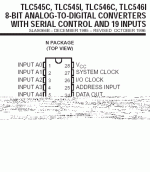safe
1 GW
- Joined
- Dec 22, 2006
- Messages
- 5,681
http://www.microchip.com/stellent/idcplg?IdcService=SS_GET_PAGE&nodeId=1335&dDocName=en026564
This powerful yet easy-to-program (only 35 single word instructions) CMOS FLASH-based 8-bit microcontroller packs Microchip's powerful PIC® architecture into a 44 pin package.The PIC16F884 features 256 bytes of EEPROM data memory, self programming, an ICD, 2 Comparators, 14 channels of 10-bit Analog-to-Digital (A/D) converter, 1 capture/compare/PWM and 1 Enhanced capture/compare/PWM functions, a synchronous serial port that can be configured as either 3-wire Serial Peripheral Interface (SPIâ„¢) or the 2-wire Inter-Integrated Circuit (I²Câ„¢) bus and an Enhanced Universal Asynchronous Receiver Transmitter (EUSART). All of these features make it ideal for more advanced level A/D applications in automotive, industrial, appliances or consumer applications.
That's great. You could do nothing but voltage dividers that feed directly into the PIC16F884's 14 A/D pins and then run the software to correct for error. A real no-brainer.
This looks very good...
You can go up to 44.8 volts with this. (14 * 3.2v)

 Let me propose one idea...
Let me propose one idea...
Since these PIC chips are burned in before being installed you could gather together the resistors you were planning to use for voltage dividing and using your best multimeter measure the precise resistance that they make. You then enter those values into the software as hardcoded initial values for your abstract model. You can then burn in the chip. Once installed the results should be pretty good as long as the deviation of the resistors is small. (things like temperature will cause error, but if that's small enough relatively speaking you could live with it)
This powerful yet easy-to-program (only 35 single word instructions) CMOS FLASH-based 8-bit microcontroller packs Microchip's powerful PIC® architecture into a 44 pin package.The PIC16F884 features 256 bytes of EEPROM data memory, self programming, an ICD, 2 Comparators, 14 channels of 10-bit Analog-to-Digital (A/D) converter, 1 capture/compare/PWM and 1 Enhanced capture/compare/PWM functions, a synchronous serial port that can be configured as either 3-wire Serial Peripheral Interface (SPIâ„¢) or the 2-wire Inter-Integrated Circuit (I²Câ„¢) bus and an Enhanced Universal Asynchronous Receiver Transmitter (EUSART). All of these features make it ideal for more advanced level A/D applications in automotive, industrial, appliances or consumer applications.
That's great. You could do nothing but voltage dividers that feed directly into the PIC16F884's 14 A/D pins and then run the software to correct for error. A real no-brainer.
This looks very good...
You can go up to 44.8 volts with this. (14 * 3.2v)
Since these PIC chips are burned in before being installed you could gather together the resistors you were planning to use for voltage dividing and using your best multimeter measure the precise resistance that they make. You then enter those values into the software as hardcoded initial values for your abstract model. You can then burn in the chip. Once installed the results should be pretty good as long as the deviation of the resistors is small. (things like temperature will cause error, but if that's small enough relatively speaking you could live with it)






